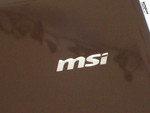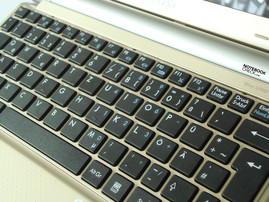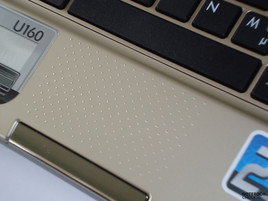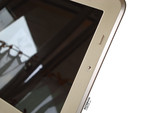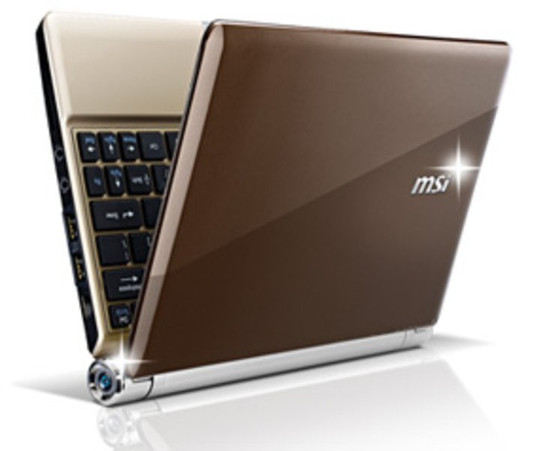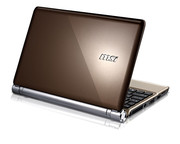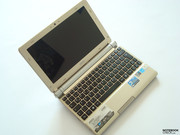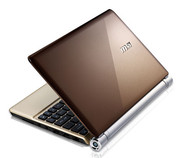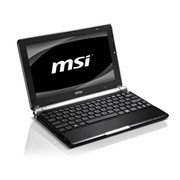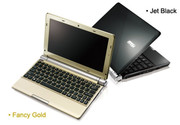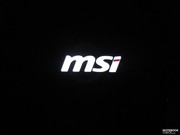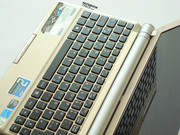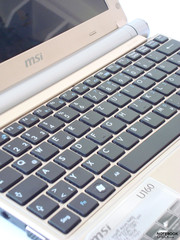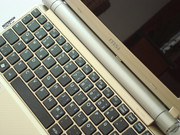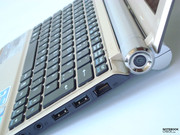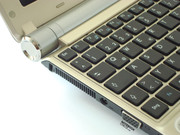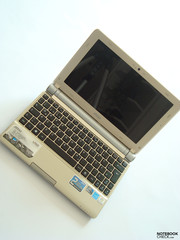Review MSI Wind U160 Netbook
Small. Light. Wind.
The manufacturer MSI beefs up once again and expands its Wind range by the U160 with a 10 inch WSVGA display, Intel Atom N450, one GB DDR 2 RAM and 160 GB hard disk. An Intel GMA 3150 chip, already integrated into the Atom N450 CPU, is used for the graphic solution.
Aside from a very good battery life supplied by the included battery, the Wind U160 has a quite good workmanship and a compactness that also impressed us. As for the design, the Wind U160 is available in two alternatives called Fancy Gold and Jet black by the manufacturer. Our test device is the gold-brown Fancy Gold netbook, which differs quite evidently from the masses in its looks. If you would rather have something more classic, the Wind U160 in Jet Black is available for you.
Case
The Wind U160 has a compact and quite solid plastic case, which defies selective pressure very well. The workmanship has to be mentioned positively here, too. The single components merge nicely without leaving large gaps between the single parts.
Opening and closing the 10 inch display is easy and doesn't make any disturbing squeaking noises. The display is kept in place stably by two small hinges that teeter a bit. If the two GB DDR2 RAM built-in ex factory isn't sufficient, you can remove the RAM cover, intended just for that, on the base unit's bottom and extend the RAM.
The MSI Wind U160's design can even uphold the glances of demanding users. Thus, it could already attract attention at the CeBIT and immediately won the much coveted iF Product Design Award 2010. The Wind U160 doesn't leave much to be desired in terms of mobility with a construction height of only 25 millimeters and a weight of a bit more than a kilogram.
The Wind U160 is available in two different colors. Either in a classic black (Jet Black) or in a somewhat more daring brown-gold (Fancy Gold). The display's back is made in high-gloss and gives the netbook a dignified appearance. However, fingerprints on the high-gloss surfaces due to constant opening and closing of the display lid will become be routine. The white lit MSI logo, decentered somewhat to the right on the display's back, first really stands out in dimmed rooms.
Connectivity
The small ten inch netbook has the most important ports that are needed for everyday use.
All available ports are placed on the prototype's sides. Thus, we find a port for connecting a Kensington lock on the left. A louver, power plug, analog VGA-out, USB port and mechanical WLAN switch can be seen right beside that.
A 2-in-1 cardreader (for SD, MMC), immediately followed by audio sockets for microphone and headphone, is on the right. Moreover, the other two USB ports and the LAN port are found there. The power button is also found in the hinge's area and is placed quite well here.
The meanwhile standard webcam should also be mentioned and should prove to be fully sufficient for video conferences with 1.3 megapixels. The corresponding array microphone is integrated on the display bezel's right.
The Wind U160 is even well equipped in terms of communication hardware. Thus, there is also a WLAN module (802.11bgn 1T1R Mini Card Wireless adapter) and Bluetooth 2.1 adapter with EDR for more mobile freedom onboard, aside from a LAN interface (Realtek PCIe FE Family Controller).
The Wind U160 is even well equipped in terms of communication hardware. Thus, there is also a WLAN module (802.11bgn 1T1R Mini Card Wireless Adapter) and Bluetooth 2.1 adapter with EDR for more mobile freedom onboard, aside from a LAN interface (Realtek PCIe FE Family Controller).
Talking about internet and mobility: The manufacturer MSI allegedly has a Wind U160 configuration with a UMTS card slot as an exciting and definitely interesting option, whereby such models haven't been found yet. The netbook would then be able to be used everywhere for accessing the internet via a fast 3.5G HSDPA connection, that is if there is an appropriately developed network.
Input Devices
Keyboard
A further highlight of the Wind U160 is its keyboard. It is quite sturdy in regards to pressure and barely bends despite the chiclet keyboard. Typing proved to need a bit of getting used to due to the minimized keys, though. Ultimately, we could type fairly smoothly after a longer accommodation period, whereby a few extra key strokes couldn't be completely prevented even then. We would describe the typing feel as okay. In any case, an external keyboard is recommendable for longer and serious work, as the built-in keyboard isn't bad but can't keep up with a reasonably good desktop keyboard, anyway.
Touchpad
As for the mouse replacement, we would describe it as very precise and pleasant. The touch-sensitive touchpad has a knobby surface that merges smoothly, without any visible gaps or edges, into the wrist-rest surface. A long, chrome key, which takes over both mouse keys functions, is found directly underneath it. Both the touchpad and the mouse keys do their intended tasks well and without problems.
Display
The Wind U160 from MSI has a 10 inch widescreen display with a reflective surface and screen size of 25.5 cm. Furthermore, the energy saving and long life LED backlight WSVGA display has a maximum resolution of 1024x600 pixels. If you need a higher resolution, you'll have to use an external monitor that is connected via the analog VGA-out.
Due to the responsive display of just eight milliseconds, stated by the manufacturer, streaks aren't an issue for the Wind U160 in videos or games. This, however, should be future users' least concern in view of the expected Pine Trail base's performance.
The manufacturer MSI allows itself one slip-up in the display illumination. Thus, the measurements range between 125.8 cd/m2 in the lower right corner up to a maximum rate of 190.6 cd/m2 in the display's center. This difference isn't usually visible during operation - that is unless you often work on pure white backgrounds.
| |||||||||||||||||||||||||
Brightness Distribution: 66 %
Contrast: 176:1 (Black: 1.08 cd/m²)
The weak display brightness combined with the glare-type display gives the MSI Wind U160 a bit of a hard time working mobile in nature. You can only see something on the display with a lot of effort. Thus, a reasonable working becomes almost impossible.
In regards to viewing angle stability, the built-in screen also reveals weaknesses. Thus, dimming and color deviations turn up very quickly on the display already when the horizontal viewing angle is altered, or even on both the vertical and horizontal plane when the sitting height is changed. Consequently, it will be necessary to frequently adjust the display regularly.
Performance
Netbooks are known for not being made for performance. Our MSI Wind U160 isn't an exception in this regard, either. Although our test netbook is equipped with an Intel Atom N450 processor with a clock rate of 1.6 GHz, our commands, such as opening a file or calling upon an internet site, is executed with a delay of about one to two seconds. All netbook users just simply have to accept this fact, or buy a notebook with more performance right away. If you acquire a netbook and expect the performance of a notebook, you'll also be disappointed by the MSI Wind U160.
However, if this fact is clear and the expectations in regards to performance are according, you can have fun with the MSI Wind U160. Surfing, writing emails, listening to MP3s or watching movies stored on the hard disk (no HDs) isn't a problem for our test netbook.
Even older games with simple, not too demanding graphics are possible to a certain extent, and if they don't require a dedicated 3D accelerator. The given performance is fully sufficient for use as a second computer or simply to look into the internet on the go.
When you compare the benchmark rates, the Wind U160 isn't much better or worse than current netbooks of other manufacturers that have been reviewed by us recently. For example HP's Mini 210-1021EG or Samsung's NP-NB30TSP-PS1 netbook.
| 3DMark 2001SE Standard | 2875 points | |
| 3DMark 03 Standard | 746 points | |
| 3DMark 05 Standard | 308 points | |
Help | ||
A Western Digital 2.5 inch sized Scorpio Blue hard disk (WD1600BEVT), with a memory capacity of 160 GB supplies enough storage room and does its work with 5400 revolutions per minute. The rates are all within a green field in view of the access and transfer rates. However, we could hear a hard disk clicking now and again.
Emissions
System Noise
The till now really rather acceptable impression is dimmed by following two points. Namely by the little MSI Wind U160's system noise and temperature emissions, which might be crucial for a purchase decision. A consistently running fan in idle mode would very likely be a reason for exclusion, even if the determined rate is only 33.5 dB (A) and is actually perceived as quiet.
The fan's noise increases to an average of 35.5 dB (A) under load, with an odd spike to a maximum of 37.4 to 40.1 dB (A) on our measuring device, and which is very well audible then.
In return, the hard disk runs along with 34.2 dB (A) with the one or other loud click noise at data accessing.
All this creates a noise level that is still within a green field even under load, but is at the same time always present. This doesn't have to be the case, especially in idle mode, as other manufacturers' devices have proved.
Noise level
| Idle |
| 33.5 / 33.5 / 33.5 dB(A) |
| HDD |
| 34.2 dB(A) |
| Load |
| 35.5 / 40.1 dB(A) |
 | ||
30 dB silent 40 dB(A) audible 50 dB(A) loud |
||
min: | ||
Temperature
Aside from the fan characteristic, or rather fan control, the directly related temperature emissions supply reason for complaint.
Whilst the established rates look very promising on both the MSI Wind U160's upper and bottom side in an idle state, it unfortunately changes under continuous system load. The measured temperatures on the upper side, that is wrist-rest and keyboard, are also alright under load, but the bottom side of the small ten inch computing servant shows a different picture. We can determine a whole 44.3 degrees Celsius in the lower left area, which is very high for a constantly running fan in a netbook with Intel's Atom CPU. Competitors prove that this can be different with measuring rates under the 40 degree mark.
Although pleasant working on the lap is hardly possible with 44.3 degrees Celsius under load, the restrictions in daily netbook use stays within limits. Common office applications usually put a demand on the device far below the level of our stress test, which rather simulates extreme conditions.
(+) The maximum temperature on the upper side is 36.3 °C / 97 F, compared to the average of 33.1 °C / 92 F, ranging from 21.6 to 53.2 °C for the class Netbook.
(±) The bottom heats up to a maximum of 44.3 °C / 112 F, compared to the average of 36.6 °C / 98 F
(+) In idle usage, the average temperature for the upper side is 31.2 °C / 88 F, compared to the device average of 29.8 °C / 86 F.
(+) The palmrests and touchpad are reaching skin temperature as a maximum (32.4 °C / 90.3 F) and are therefore not hot.
(-) The average temperature of the palmrest area of similar devices was 29.3 °C / 84.7 F (-3.1 °C / -5.6 F).
Loudspeakers
Let's now look at the MSI Wind U160's sound rendering. This is taken care of by an Intel 82801GBM ICH7-M - High Definition Audio Controller, whose signals are emitted by two loudspeakers found on the base unit's bottom front area. The reproduced sound is sufficient, despite the small size, just like the device's maximum volume. However, the domestic stereo system or high-quality headphones should also be preferred here because the provided soundscape lacks power and volume, especially in the lower sound ranges.
There is no contorting or overdriving heard, even at maximum volume output. However, the produced sound makes a rather thin and partly tinny impression. These little flaws can simply be avoided with a stereo system, active boxes or good headphones, as aforementioned.
Battery Life
The MSI U160 feels at home here. According to the manufacturer's homepage, the test device is supposed to achieve a runtime of up to 15 hours with the six cell battery. We weren't able to reach 15 h in our tests with the BatteryEater tool, but the 586 minutes in a runthrough with BatteryEater Reader's tool is also quite impressive. After all, that is nine hours and 46 minutes of mobile independence before the MSI Wind U160 cries for the mains again. An equally satisfactory result is reached even under load. The included lithium Ion battery with a capacity of 65 WH (11.1 volts, 5800 mAh) is exhausted after 307 minutes of continuous load.
Surfing via WLAN in good to maximum brightness is also impressive. The mobile energy supplier comes first to its end after five hours and 44 minutes. Thus, the Wind U160 is definitely one of the most enduring netbooks, even if we couldn't reach the 15 hours of permanent use stated by the manufacturer.
According to MSI, enabling the "Turbo Battery" mode (FN+F10) via ECO key, is supposed to result in a considerable performance increase. A complete runtime test hasn't been executed in this state.
| Off / Standby | |
| Idle | |
| Load |
|
Key:
min: | |
Verdict
The MSI Wind U160 is yet another representative of the netbook sector. The 10 inch device with a WSVGA display and a maximum resolution of 1024x600 pixels doesn't only look great, but was also able to win the much desired "iF Product Design Award 2010". The Wind U160 is available in two colors, which are Jet Black or, like our test sample, in a successful Fancy Gold.
Aside from the chic looks, the Wind U160 can convince with a good workmanship, a good battery life, an adequate connectivity and high-end input devices. Our test sample is ideal for accessing the www - no matter if over hot spots, due to the integrated WLAN module, or the classic LAN cable. The Wind U160 is provided with a Bluetooth module as another communication option. Naturally, a UMTS version that has been announced but is not yet sold would be awesome.
Unfortunately, the display illumination, the perpetually running fan, as well as the operating temperature under load do leave a bit to be desired.
Crystal clear: The MSI Wind U160 has many strengths, but regrettably also a few weaknesses. If you can cope with these flaws, you'll get a solid, compact and well-manufactured netbook at a fair price of about 354.98 euro (amazon.at). The netbook equipped with a Windows 7 starter operating system, is delivered with a warranty period of 24 month incl. pickup & return service.





